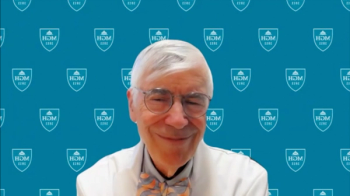
Study: Total Airway Count Can Be Used to Measure Pulmonary Decline in COPD
The research suggests a computed tomography-readable biomarker could help clinicians better understand individual cases of chronic obstructive pulmonary disease.
Total airway count (TAC) as visible in computed tomography (CT) scans appears to be associated with chronic obstructive pulmonary disease (COPD) severity and could be a meaningful predictor of pulmonary decline in such patients, according to new research.
At the same time, Ran and colleagues said advanced imaging software has made it easier to analyze the trachea tree and examine smaller airways with an airway diameter of just 1 mm using CT systems. Some previous research has suggested that a count of total CT-visible airways correlates with pulmonary function, but a longer-term study found conflicting results.
In the new study, Ran and colleagues sought to clarify the question of TAC’s association with COPD by conducting a prospective analysis that compared TAC in patients with COPD with healthy controls, and which also examined links between TAC and COPD severity.
The authors enrolled 176 people in the study, of whom 41 were healthy controls, 76 had been diagnosed with Global Initiative for Chronic Obstructive Lung Disease (GOLD) I-stage COPD, and 59 had GOLD II-stage COPD. In terms of follow-up, 139 people enrolled in the study eventually completed at least 2 spirometry measurements within 7 years of baseline.
The investigators found that, compared to healthy controls, TAC as measured by CT was reduced by 51% in patients with GOLD II and 31% in patients with GOLD I COPD, after adjustment for confounding factors.
The authors said TAC had most strongly associated with pre-bronchodilator forced expiratory volume (FEV1), pre-bronchodilator forced vital capacity (FVC), post-bronchodilator FEV1, and post-bronchodilator FEV1/FVC (both P<.001).
“TAC has the best correlation with inspiratory 10-mm lumen perimeter (Pi10; ρ=−0.751, P<.001), an evaluation indicator of the degree of airway remodeling,” Ran and colleagues said. “TAC was independently associated with annual decline in pre-bronchodilator FEV1 (P=.023), post-bronchodilator FEV1 (P=.018), and post-bronchodilator FEV1 /FVC (P<.001).”
The authors said these data suggest that CT-visible TAC is a meaningful measure of COPD severity.
“It is likely to be an evaluation indicator of the degree of COPD airway remodeling, and a predictor for accelerated decline in pulmonary function,” they added.
The investigators noted that airway remodeling can be a difficult biomarker to use by itself, since it requires manual measurement.
“CT-visible TAC can be calculated and obtained by semi-automatic quantitative software,” they said. “It is convenient compared with the current indicators of airway remodeling.”
They added that the fact that their findings suggest TAC can be used to track pulmonary decline means that physicians could better manage patients over time.
Ran and colleagues concluded that the findings not only provide a new tool for physicians, but also revealed new insights about the disease itself, since they suggest that even patients with early-stage COPD may have structural changes in their lungs. They said this finding bolsters the case for early intervention to potentially slow disease progression.
Reference:
Wu F, Jiang C, Zhou Y, et al. Association of total airway count on computed tomography with pulmonary function decline in early-stage COPD: a population-based prospective cohort study. Int J Chron Obstruct Pulmon Dis. Published online December 18 2021. doi:10.2147/COPD.S339029
Newsletter
Stay ahead of policy, cost, and value—subscribe to AJMC for expert insights at the intersection of clinical care and health economics.



























































